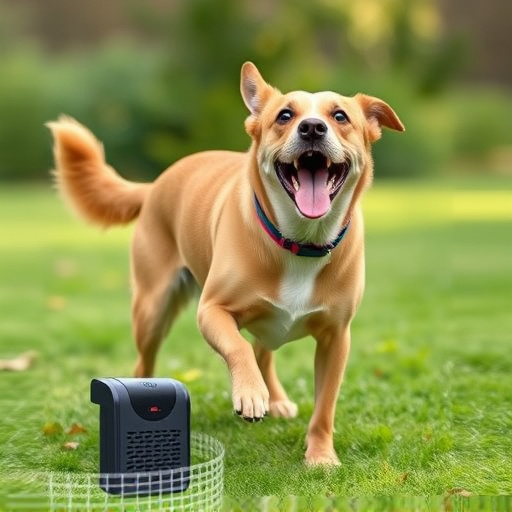Sonic dog training, utilizing electronic remote correction, offers a modern and safe method to manage canine behavior in off-leash areas like yards. An electronic dog barrier creates a virtual perimeter, providing excellent yard coverage and encouraging good behavior without physical barriers or leashes. This humane alternative to traditional punishment caters to various dog sizes and behaviors, promoting a supportive environment for successful training sessions focused on clear boundaries and positive reinforcement.
“Unleash a well-behaved companion with the power of sonic dog training, a revolutionary approach to behavioral correction. This method offers a gentle yet effective solution for pet owners seeking to enhance their dog’s performance in the yard. By utilizing electronic dog barriers, you can achieve optimal yard coverage, ensuring your dog stays within designated limits.
Our comprehensive guide explores the science behind sonic training, its benefits, and practical tips for creating a positive learning environment. Discover how this innovative technique can transform your dog’s behavior, making outdoor spaces a pleasure for both of you.”
- Understanding Sonic Dog Training: A Gentle Approach to Behavioral Correction
- The Role of Electronic Dog Barriers in Effective Yard Coverage
- Setting Boundaries: How Sonic Training Can Enhance Your Dog's Behavior
- Creating a Positive Environment: Tips for Successful Sonic Dog Training Implementation
Understanding Sonic Dog Training: A Gentle Approach to Behavioral Correction
Sonic dog training, also known as electronic dog training or remote correction training, is a modern approach to behavioral modification that utilizes sound waves to gently guide canine behavior. Unlike traditional punishment-based methods, this method focuses on positive reinforcement and subtle corrections, ensuring a safe and effective learning environment for your furry friend. By emitting high-frequency sound pulses, the electronic dog barrier can be an efficient tool in controlling unwanted actions without causing harm or fear.
This training technique is particularly useful for managing off-leash areas, such as yards, where dogs might encounter distractions like squirrels or other animals. The electronic barrier creates a virtual perimeter, allowing pet owners to redirect their dog’s attention and encourage desired behavior. With its yard coverage capabilities, this method offers a humane alternative to physical barriers or leashes, fostering a happy and well-behaved canine companion.
The Role of Electronic Dog Barriers in Effective Yard Coverage
Electronic dog barriers, also known as remote training fences, play a pivotal role in achieving effective yard coverage for pet owners. These innovative tools utilize technology to create a virtual boundary, allowing dogs to roam freely within a specified area while preventing them from entering restricted zones, such as roads or neighbors’ gardens. By emitting gentle static corrections when a dog approaches the barrier’s zone, they learn to respect the boundaries without fear or discomfort.
This method is particularly useful for large yards or areas with varied terrain, ensuring complete yard coverage without requiring extensive physical fencing. The electronic barriers are designed to be versatile and customizable, catering to different dog sizes and behaviors. They offer a humane alternative to traditional punishment methods, fostering positive training experiences while effectively managing your dog’s outdoor activities.
Setting Boundaries: How Sonic Training Can Enhance Your Dog's Behavior
Training a dog involves setting clear boundaries to ensure their safety and good behavior, both indoors and outdoors. In outdoor spaces like yards, electronic dog barriers are effective tools that utilize yard coverage to establish defined limits. These barriers emit gentle yet effective signals, teaching dogs where they can roam freely and when they need to stop and listen.
Sonic training, a component of electronic dog barriers, uses specific sounds to communicate with your pet. By combining this with consistent command training, you can enhance your dog’s understanding of boundaries. This method is particularly beneficial for active breeds or dogs with a strong prey drive, helping them stay within designated areas while enjoying outdoor playtime and exploration.
Creating a Positive Environment: Tips for Successful Sonic Dog Training Implementation
Creating a positive and supportive environment is key when implementing sonic dog training and behavioral correction techniques. One effective tip is to start by establishing clear boundaries in your yard using an electronic dog barrier. This helps in defining safe spaces for both you and your dog, allowing for better control during training sessions. By ensuring comprehensive yard coverage with the barrier, you create a controlled environment where positive reinforcement can be more easily applied.
Additionally, maintaining a calm and consistent atmosphere is vital. Dogs thrive on routine, so establishing a regular training schedule will help them understand expectations. Use sonic trainers consistently during specific times of the day, always ending sessions on a positive note with rewards or praise. This approach fosters a sense of cooperation rather than fear, making the training process more effective.
Sonic dog training offers a modern, gentle approach to behavioral correction, focusing on enhancing your dog’s overall well-being. By utilizing electronic dog barriers for yard coverage, you can effectively set boundaries and teach desired behaviors without causing harm or stress. With the right implementation, this method creates a positive environment that strengthens the bond between you and your furry friend. Remember, consistent training and patience are key to unlocking the benefits of sonic dog training for a happier, better-behaved companion.
